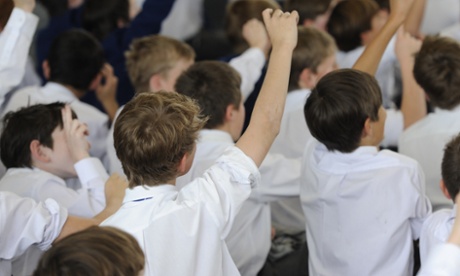
Charging a goods and services tax on private health insurance and private education could reap $2.3bn a year predominantly from well-off households, according to new analysis from a thinktank.
Debate over broadening the application of the 10% tax was restarted this week when a government backbencher, Dan Tehan, called for it to be applied to all exempt items, including health, education and fresh food – a move that could raise an extra $20bn a year.
But the suggestion immediately sparked longstanding objections that the effect would be regressive – hitting poorest households the hardest because they spend a higher proportion of their total income on such essentials. When the GST was introduced these concerns were ameliorated with personal income tax cuts.
Now the Australia Institute has suggested a way to boost revenue from the GST without hitting the poorest – by extending it to private health insurance and private education, services primarily used by higher earners.
Modelling done for the institute by the National Centre for Social and Economic Modelling (Natsem) found only 9% of the $2.3bn a year raised by the extension would come from the poorest 20% of households, 34% would come from the richest 20% of households, and 60% of the revenue from the richest 40%.
The move would also shield rural and regional areas, with 71% of the revenue raised from capital cities.
Of the $2.3bn, $1.53bn would come from purchasers of private health insurance and $790m from those using private schools.
“As the revenue base in Australia is continually downgraded, the government needs to find ways of increasing revenue. The alternative – cutting spending – has been rejected not only by the Senate but also by the general public. The budget has a revenue problem and broadening the GST to private schools and private health insurance is a first step towards plugging the revenue hole,” the Australia Institute said.
The former treasury secretary Martin Parkinson repeatedly warned that unless Australia raised more revenue from indirect taxes like the GST and excise, workers would inevitably pay more in income tax.
And while the prime minister, Tony Abbott, said in 2013 that “the GST won’t change – full stop, end of story” the government is leaving the door open to take tax reform to the next election and is preparing to launch a taxation white paper that could pave the way for GST changes as well as higher taxes on superannuation.
Tehan insisted regressivity of a broader application of the GST could be fixed by compensation.
“Tax reform is necessary,” he told Guardian Australia. “We’ve had the political courage, unlike the Labor party, to put it on the agenda through our tax white paper process and my view is that we need to have a discussion with the Australian people about how we are going to maintain our current standard of living. Tax reform is a key component of that.”
He said the impact on the poor could “be dealt with through compensation payments …. You would have a compensation package which would be applied directly to those that it would impact on. The OECD have made this point clear: you address welfare through direct welfare payments; you don’t address welfare through exemptions to everyone in your tax system.”
Abbott said this week he was happy to have a debate about the GST but it would not be changed before the next election.
“I certainly don’t mind members of parliament discussing the GST, but the GST simply can’t change unless all of the states and territories agree and there is a political consensus in the parliament … So, I know that lots of people hyperventilate whenever the GST is mentioned, but it’s important to remind people that it simply cannot change unless all of the states and territories, including the Labor states and territories, agree and there is a consensus in the parliament and it won’t change in this term of parliament,” Abbott said.

